Don’t forget to scroll down to read previous posts and click on the green text to find other materials!
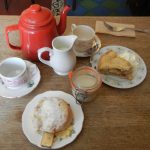 While history and literature are endlessly fascinating, when I’m traveling I always find myself to be keenly interested in the details of daily life and other miscellaneous trivia. How are grocery stores arranged in other cultures? What are the rituals of the morning meal? How do common idioms do the work of everyday communication? How does geography, or weather, or a relationship with neighboring places influence culture? As we approach our departure date, I have been thinking about a few small items of interest or amusement that I wanted to convey to you, so this post is a collection of bibs and bobs.
While history and literature are endlessly fascinating, when I’m traveling I always find myself to be keenly interested in the details of daily life and other miscellaneous trivia. How are grocery stores arranged in other cultures? What are the rituals of the morning meal? How do common idioms do the work of everyday communication? How does geography, or weather, or a relationship with neighboring places influence culture? As we approach our departure date, I have been thinking about a few small items of interest or amusement that I wanted to convey to you, so this post is a collection of bibs and bobs.

Land of the Midnight (or 11 p.m.) Sun
While we are in Ireland, as Midsummer approaches the sunset each day will occur at around 10 p.m., and it will be light outside until nearly 11 p.m. We will be situated, after all, at the same latitude as Hudson Bay. The sun will rise around 5 a.m. during our stay, so no relief at that end. The very long days are great for sightseeing and photography but not that great for sleeping if you are sensitive to light and dark. When I’m in Ireland, I find I always have to acclimate myself to this new definition of “nighttime” and work on my sleep habits.
“Are you all right?”
Although Irish English is closer to American English than is British English in both diction and pronunciation, you’ll hear many wonderful Irish/British phrases and words that are usually easy to understand from the context. But here’s one that sometimes gives Americans pause. In restaurants and bars, the server is likely to greet you at your table with the phrase “Are you (ye) all right?” or “All right, are ye?” or some variation of it. This is not an inquiry about your health: it means, “Can I help you?”
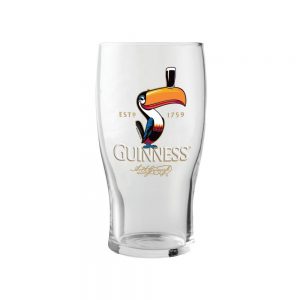
Pint v. Glass and Guinness Etiquette
If you are a beer drinker, there are several things you need to know when ordering at a bar or restaurant. Beers in Ireland come in two sizes: pint and glass. A pint is 570 ml., which is about 19 oz. or 1.2 US pints. A glass is a little more than half a pint and is served in a thinner, shorter glass. Pints seem to be ordered more often, but glasses are also popular, especially among the ladies. If you say “a pint of Guinness, please” or “a glass of Murphy’s, please” the bar tender will know exactly what you want. Guinness is poured into glasses of both sizes following a time-honored “pour” method that requires patience on the part of the drinker. When ordering a Guinness, never grab the glass to drink until the “pour” is complete and the white head and the dark brown stout have completely separated–separation takes about five minutes. If beer is not your thing, another nice, Irish-made drink to order at bars is Bulmers (called “Magners” outside the Republic of Ireland) Cider, a hard cider that comes in both apple and pear flavors,
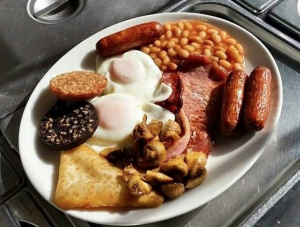
“Full Irish”
While most of our hotels will have breakfast buffets, some will also offer an ordered “hot breakfast,” meaning some combination of eggs and meat or even pancakes. I recommend that you go for the “full Irish.” A “full Irish” breakfast is a joy to behold. It usually includes one or two fried eggs (but you can ask for scrambled or poached), Irish bacon (more like what we would call “Canadian bacon”), a couple of Irish sausages, slices of “black and white pudding” (another kind of sausage), a grilled tomato, and toast. Sometimes you will get baked beans or sautéed mushrooms with your “full Irish.” If a “full” is too daunting, you may always ask for any combination of these elements, such as egg, sausage, and grilled mushrooms—or whatever you please. In Northern Ireland a “full Irish” is called an “Ulster fry” or a “heart attack on a plate” and will also include potato or soda “farls”—delicious triangular bread-like things. North and South will sometimes add a potato cake of some sort. Unless you are a vegetarian, you should really try a “full Irish” once at least. Hey, you’re on vacation—go for it more than once!
Country Codes
When telephoning, the country code for the Republic of Ireland is 353 and the code for Northern Ireland (and all of the UK) is 44. While in Ireland if you want to call someone in the US on your cell phone, use the plus sign (European long distance) and the country code; like this: +1-404-555-5555. The +1 followed by the ten-digit number is also used if you want to call someone from the group with an American phone while we are in Ireland.
Cash v. Credit Cards
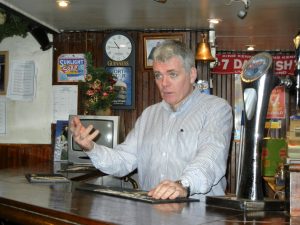 You will need cash (Euros in the Republic, Sterling in NI), as some smaller businesses don’t take credit cards. I use my ATM card all the time in Ireland on both sides of the border. You will probably need to alert your bank that you are traveling. American Express cards are accepted less widely there than here, so having a Visa or MasterCard is a must.
You will need cash (Euros in the Republic, Sterling in NI), as some smaller businesses don’t take credit cards. I use my ATM card all the time in Ireland on both sides of the border. You will probably need to alert your bank that you are traveling. American Express cards are accepted less widely there than here, so having a Visa or MasterCard is a must.
Tipping
The Irish have a different attitude about tipping than we do; they see it only as gratitude for excellent or extra service. In the US, tipping provides a substantial part of a worker’s wage, while in Ireland and the UK, servers, bartenders, and other workers make better hourly wages. In Ireland it is not customary to tip when ordering drinks only at bar. When ordering food at a bar or restaurant, you can tip up to ten percent or round up a few Euro. Usually the server will bring a handheld credit card machine to your table, but the process does not always involve a line on the bill for a tip, so cash tipping is generally favored. In a taxi, the tip usually consists of rounding up or adding some loose change.
Bathroom Talk
Knowing what to ask for when you need to use the facilities is an important topic in any country. It is quite common in Ireland to say “toilets,” so “Where are the toilets?” is the most common way of asking. Other common terms are “Ladies” and Gents.” Everyone will  understand what you want when you say “bathroom.” In the Irish language, the terms are “Mná” (mn-AWE) for the women’s bathroom and “Fir” (FEAR) for the men’s.
understand what you want when you say “bathroom.” In the Irish language, the terms are “Mná” (mn-AWE) for the women’s bathroom and “Fir” (FEAR) for the men’s.
Adaptor
The only adaptor that works in Ireland is “Type G,” the one that also works in the UK and Hong Kong. It is pictured below. You can purchase these at travel stores, Target, and online. I get mine from amazon.com
More travel tips…A more complete list of travel tips is available in the Trip Basics section of this site.

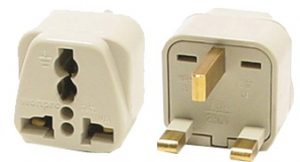
Christine,
Looks like our itinerary will keeping us moving from breakfast to dinner – should we not count on time for lunch? I do believe you said bring snacks on the bus to tide us over, a good tip! And then there’s another reason for the full Irish breakfast!
Barbara
Don’t worry, time for lunch is always included!
Excellent! Guess I’d best come up with a foodie limerick for asking such a silly question!
June 2, 2014 – Thank you, Christine, for the very informative emails/updates and the amount of time you’ve spent to send us the plethora of information. I hope I can remember half of it. This is already a most educational trip, and I know it will be fun, too! Tom and I are looking forward to seeing everyone very soon.
I’m only two yrs off on the date — oh well!!!! I’m sure that was a typo. 🙂
I’like to go back to June 2014, too! That’s when I started my sabbatical and year-long residence in Ireland!
Great to hear from you! I’ve had fun thinking of things to write about that pertain to our itinerary. I’m glad you have enjoyed the posts!